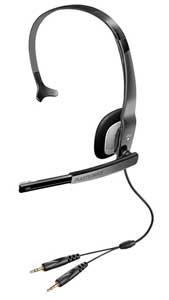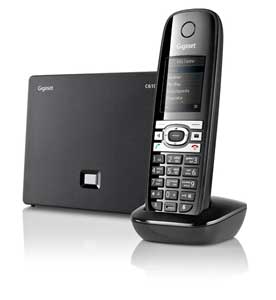Alternative to softphone
Description of the “life path” from the software tool to the hardware solution.
Since 2008, began working at home. The question of voice / telephone connection that is very important for working with my clients was decided by installing a softphone on the laptop and connecting to a working IP PBX via SIP. “Hardware” was solved by the simplest wired headset and an additional USB audio adapter, since Macbooks used did not have a microphone input.

Liked the following features:
However, there was a negative:
')
There was a desire to try some DECT headset with a really high- quality voice quality, but the price of 7000 rubles for the simplest option stopped.
In addition, the headset left the “binding” to the computer and software (!).
The experiments ended immediately and forever after I forgot to turn off the softphone for the night and it discharged the battery of the mobile phone. In the morning the alarm clock did not sound and I was very late for an important meeting.
In addition, I found a lot of positive reviews about such “tubes” from Siemens (Gigaset) to which I have had respect since my youth, when I traded them (2000–2005). For workmanship and sound quality, for reliability, for more or less working soft stuffing.
Radiotelephone DECT Gigaset C610A IP with very adequate price

Main:
“Buns”:
It is necessary to find a wired headset that connects to this handset (the cord is not more than half a meter) and return the “hands-free”.
A base, a glass, a handset and two charges are a lot if you take it from home to office or vice versa. But to put another base in the office and take only the handset with you is very convenient. The tube is “smart” and calmly connect to the base in the zone of which it is located.
Past
Since 2008, began working at home. The question of voice / telephone connection that is very important for working with my clients was decided by installing a softphone on the laptop and connecting to a working IP PBX via SIP. “Hardware” was solved by the simplest wired headset and an additional USB audio adapter, since Macbooks used did not have a microphone input.

Liked the following features:
- “Freedom of hands” - the ability to fully work on a computer during a telephone conversation. Relevant when consulting clients with the need to write something in CRM or look for information in the documentation.
- Dialing by copying from CRM or any text source (site).
- Compactness, which is important when leaving home to office.
However, there was a negative:
- The wire, which was tangled, dangled and in every way finely strained.
- Attachment to the place is a consequence of the wire.
- Binding to the computer and software. To accept a call or an outgoing call, a running software and a visible screen were needed (hot keys are rarely embedded in softphones).
- Soft! Despite the variety of programs, there were units with the necessary functionality for reliable communication with my working IP PBX (features ...). And among them, only one with acceptable ergonomics (X-Lite for Mac). And still the program often “fell” :-(
')
Attempt the first. Bluetooth headset
Having a laptop with Bluetooth, several times there was a desire to at least remove the wire. However, all tried out Bluetooth headsets did not give me enough voice quality. Both cheap (700 rubles) and expensive (4000 rubles) headsets were clearly defined by “digital” distortion, despite a pile of promises from manufacturers.There was a desire to try some DECT headset with a really high- quality voice quality, but the price of 7000 rubles for the simplest option stopped.
In addition, the headset left the “binding” to the computer and software (!).
Attempt the second. Softphone in mobile phone
The iPhone is a good thing, but only one softphone of the many installed during the experiments started working with a working IP PBX (Zoiper). The rest of the unknown reasons could not do it. For example, one of the tested softphones (3cx) did not want to work with the “sub-PBX” installed in one of the regional offices - I was not heard (perhaps there were problems with codecs).The experiments ended immediately and forever after I forgot to turn off the softphone for the night and it discharged the battery of the mobile phone. In the morning the alarm clock did not sound and I was very late for an important meeting.
Attempt last. IP DECT cordless phones
I accidentally discovered that there are variants in the DECT family of radio tubes with a base unit that is connected to both the PSTN and via SIP to a PBX / service via LAN.In addition, I found a lot of positive reviews about such “tubes” from Siemens (Gigaset) to which I have had respect since my youth, when I traded them (2000–2005). For workmanship and sound quality, for reliability, for more or less working soft stuffing.
The present
Radiotelephone DECT Gigaset C610A IP with very adequate price

Main:
- the base unit connected to the PSTN line and to the LAN + a separate “cup” for charging = the most convenient placement of parts around the house
- 6 IP lines with different settings
- the settings you need for me. For example:
- selection of the desired codec (working PBX works only by u-Law).
There are: G.722, G.711 a-law / G.711 u-law, G.726, G.729. - “Manual” indication of SIP and RTP ports for their further “forwarding” on the router
- selection of the desired codec (working PBX works only by u-Law).
- no wires - 300 meters in a straight line and 50 meters in the house
- decoupling from laptop and software
- the ability to connect a wired headset (returning “hands free”)
“Buns”:
- answering machine
- web interface
- dial plans (for example, “9” is for PSTN and “8” is for IP 1)
- 180 hours standby time and 12 hours talk time (passport data)
- “baby monitors” mode - for the future :-)
What happened
- “Base” near the router - somewhere far away, where all the wires.
- A tube with a charging glass with four lines:
- IP PBX of the main office with my main internal number + outgoing calls on city (Moscow) and long-distance / international channels
- IP PBX Novosibirsk office for outgoing calls in Novosibirsk (frequent work necessity)
- sipnet.ru for long distance calls to friends
- home phone (PSTN)
- The possibility of remote (from the computer) dialing (via any of the selected lines) and receiving a call with the display of the caller
- Phonebook, importing data into vCard - I just exported working contacts from the mac-address book and put it into the phone through the web-interface.
- No problems with the computer turned on, the screen turned on, “correct” software.
Future
It is necessary to find a wired headset that connects to this handset (the cord is not more than half a meter) and return the “hands-free”.
PS Mobility
A base, a glass, a handset and two charges are a lot if you take it from home to office or vice versa. But to put another base in the office and take only the handset with you is very convenient. The tube is “smart” and calmly connect to the base in the zone of which it is located.
Source: https://habr.com/ru/post/138237/
All Articles